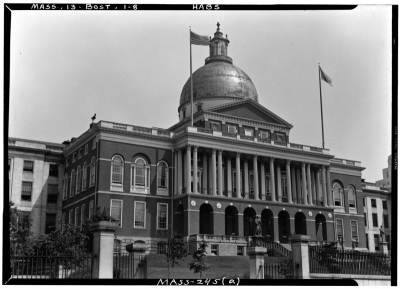Part 6 of a weekly series of blogs about Rex Wailes’ 1929 trip to the USA and Canada.
_750_426_68.jpg)

Massachusetts New State House
I got a map and guide of Boston and set out. Had a new glass put in my watch – they call it a ‘crystal’. Got lunch at a quick lunch counter in a store. Went to a ticket office for information about Cape Cod and Nantucket and had a look from the outside at the two old Baptist Churches, both very fine and recently sandblasted. I went inside the Old & the New State House. The new one faces the ‘Park’ but the front is masked by large trees instead of having a clear avenue as it should. The old centre part is of red brick and stone with a gilded dome. The old State House is red brick in the style of the period. It has not long been taken over as a Museum by the Boston Historical Society, and contains a number of interesting relics and some junk. The Spiral Stairway in the centre is very striking – altogether a very pleasing place.
To get information about windmills I went to the Society for the Preservation of New England. Here I struck oil, was shewn a number of illustrations and found a number of names of mills in Cape Cod, Rhode Island & elsewhere. To anticipate, I called again on Wednesday morning and saw Mr. Appleton, the Secretary, who was at a meeting the previous afternoon. He ‘phoned Mr Macy who invited me to lunch at the Boston City Club and gave me three letters of introduction for use in Nantucket.

First Harrison Gray Otis House, headquarters of the Society for the Preservation of New England
The headquarters of the S.P.N. England are in a fine old red brick house, next door to a branch of the Boston Library, which is in a fine old Baptist Church. I should have liked a lot of time to examine both. Boston itself is a city – in the center at least – of narrow winding streets – rather like the City of London. Their street cars are on the surface only, outside the centre of the town. They go down underground later and all seem to meet at Park Street where you change. Here also is their ‘subway’ like a cross between our tube and metropolitan. The fare is a ”dime” (10 cents) anywhere. At a station you deposit in a box, a ratchet is released automatically, and you go through the turnstile. On the street you deposit in to a box at the entrance to the car. The conductor can and does withdraw the money, which is registered on a meter above, both “trip” and total.

Boston YMCA, 1910s
The Y.M.C.A. – they call it the “Y” is an enormous institution on Huntington Avenue. It seems to contain about everything possible, it does things cheaply. It has a “Cafeteria” – what we should call a small restaurant – and a “spa” which is what we should call a soda fountain, but with a difference. The cafeteria is open from 11.30 a.m. to 6.30 p.m. and the spa just about 24 hours a day. At the spa one waits on oneself and most seem to eat at the counter. They sell all kinds of soft drinks, sandwiches, cereal foods, fried things and fruit. My supper was a cream cheese & olive sandwich and some sort of malted milk drink, much too sweet incidentally. My breakfast, on the recommendation of the bar-man was some sort of fried doughnut stuff and coffee – I didn’t realise what it was until I had bitten it, or I wouldn’t have had it. They have a laundry service too and a “check room” where I left my “Revelation grip”. They can do a two-day service in laundry if required.
In the evening I went to the Symphony Hall, close to the “Y” to what they call “The Pops” They are out of season concerts of the Boston Symphony Orchestra. The programmes are all light music – classical with “extras” (encores) of what I should call “cinema music”. They play on the stage at the end, and when, as happens all this week, the classical dancers – Isadora Duncan’s ballet – appear, the stage is cleared and the orchestra comes down to the front. The programme was in three parts – the dancing being the last and refreshments were served in the two intervals and during the second part.

